

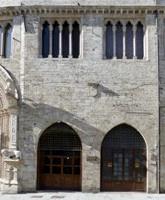
The Collegio della Mercanzia (merchants' guild) is probably the oldest and was certainly the most important guild in the city. The rich merchants who were its members belonged to a class known as the “popolo grasso”: this distinguishes them from the “popolo minuto”, who generally belonged to the tradesmen’s guilds.
The Collegio della Mercanzia was among the Perugian guilds who represented the “popolo” in the political events that led to the exile of the nobles in 1223. The arbitration process carried out for Honorius III by Cardinal John Colonna in October 1223, which paved the way for their return, required (inter alia) the dissolution of the offending guilds. A month later, Honorius III allowed the Collegio della Mercanzia to re-form, provided that it concentrated on its commercial function rather than on its political aspirations. This papal preference probably marks the start of the divisions that were subsequently to become apparent between the “popolo grasso”and the “popolo minuto”.
The appearance of the office of Capitano del Popolo in Perugia in 1255 was probably as a result of a resurgence in influence of the guilds representing the “popolo grasso”. In 1260, the Collegio della Mercanzia was given responsibility jointly with the Collegio del Cambio for all provisions relating to the minting of money in the city. The Collegio della Mercanzia provided four of the five “consuls of the arts” who supported the Capitano del Popolo in the government of Perugia from 1266.
From the 1280s, the representation of the Collegio della Mercanzia was reduced to two, allowing the Collegio del Cambio to provide the third consul and the other guilds (representing the “popolo minuto”) to provide a further two on a rotating basis. The guilds as a whole increased their power at the expense of the nobles, and in effect assumed the government of the city in 1295.
The “popolo minuto” further increased their power in 1303, when the “consuls of the arts” were replaced by a magistracy of ten priors (the Priori delle Arti). However, the Collegio della Mercanzia and the Collegio del Cambio still had special privileges in relation to the election of the priors:
-
✴the Collegio della Mercanzia provided two permanent members from the inception of this form of government; and
-
✴the Collegio del Cambio usually provided one member, an arrangement that became permanent in 1385.
The guilds both administered charitable institutions:
-
✴the Collegio della Mercanzia administered the Ospedale di Sant’ Egidio, a hospice for the poor in what is now Corso Garibaldi; and
-
✴from 1399, the Collegio del Cambio owned the tiny church of San Giacomo at Porta San Pietro and the nearby Ospedale di San Giacomo, both of which ministered to pilgrims.
Members of the nobility (who had been included in the Libro Rosso of 1330) were prohibited from guild membership. However, Braccio Fortebracci overturned this provision when he assumed control of Perugia in 1414. Nobles subsequently came to dominate the college, and non-nobles were explicitly prohibited from membership in 1670.
College Premises
The Collegio della Mercanzia met originally in Santa Maria del Mercato (later Santa Maria del Popolo). It acquired prestigious premises under the Palazzo dei Priori in ca.1390 as payment of a debt owed by the Commune.
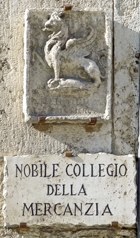
The Collegio della Mercanzia took over the Cappella di San Bernardino in the Duomo in 1515.
Sala dell' Udienza
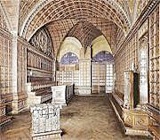
The vaulted audience chamber is entirely faced in wooden panels that have recently been restored. The College bought the carved the benches (1462) by Costanzo di Mattiolo from the Collegio dei Notai in 1865.
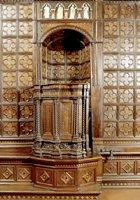
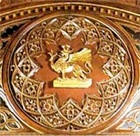
Sala dell' Archivio
This archive preserves the guild’s decorated registers of members for the years 1323, 1356 and 1599. The register of 1356 contains illuminations (1377) by the important Perugian miniaturist Matteo di Ser Cambio.

